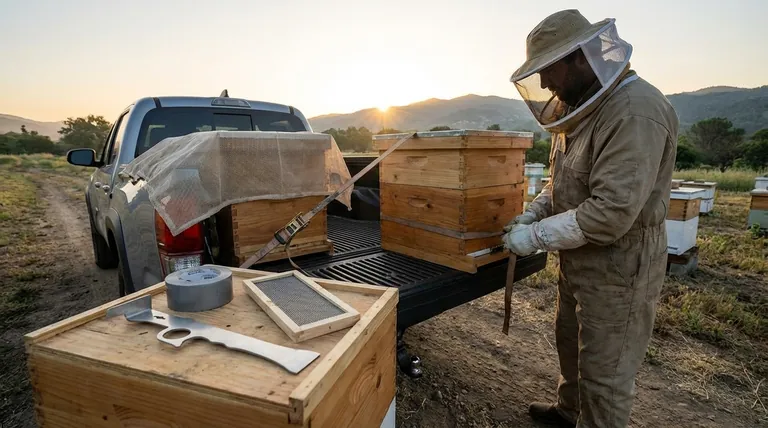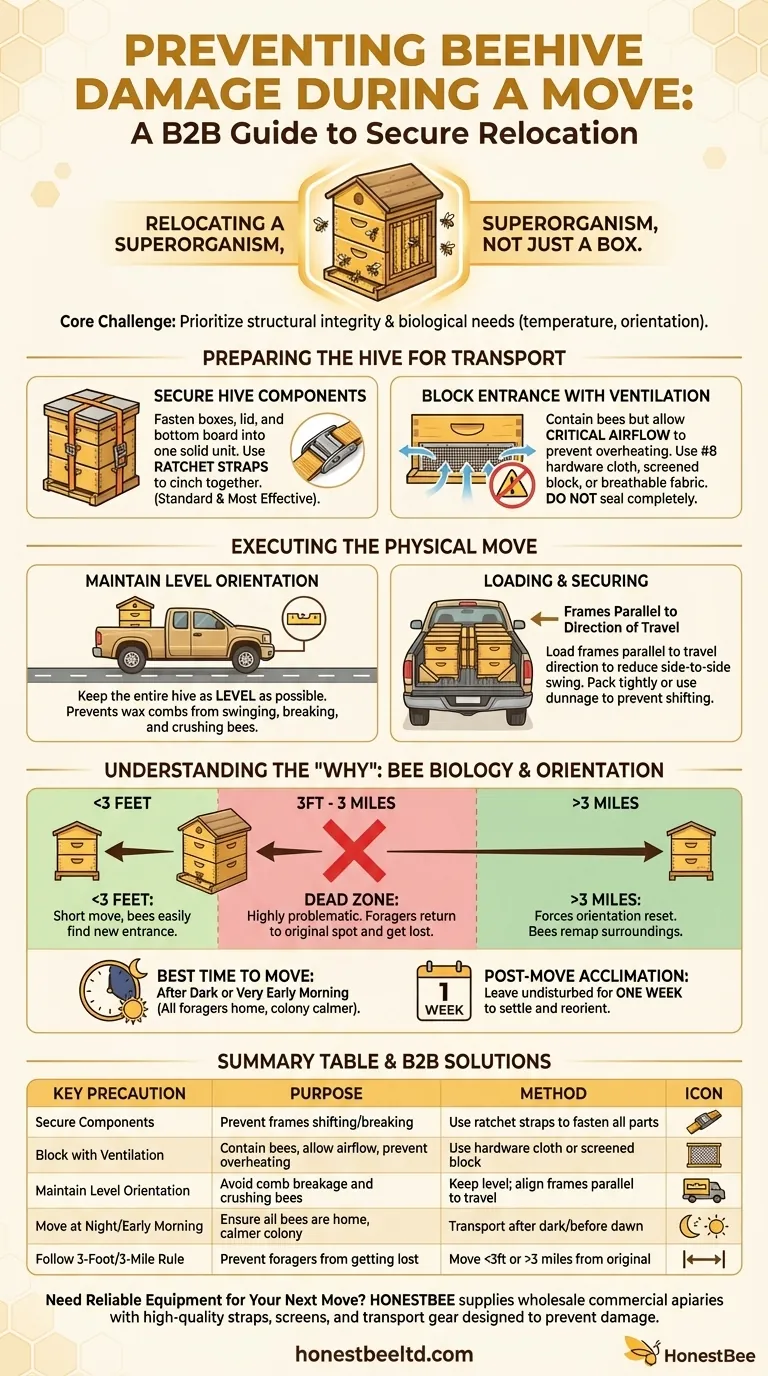To prevent hive damage during a move, you must physically secure all hive components together, keep the entire hive as level as possible during transport, and seal the entrance in a way that blocks bees from escaping but still allows for critical airflow. These actions prevent the internal frames from shifting, breaking, or crushing bees, and stop the colony from overheating in transit.
The core challenge isn't just moving a wooden box; it's relocating an entire superorganism. Successful hive moving requires careful preparation that prioritizes both the structural integrity of the hive and the biological needs of the colony, primarily temperature regulation and orientation.

Preparing the Hive for Transport
Before you lift the hive, it must be properly secured. A failure at this stage risks breaking the hive apart, causing catastrophic damage to the comb and colony.
Securing Hive Components
The individual boxes (supers), lid, and bottom board must be fastened into a single, solid unit. Ratchet straps are the standard tool for this, cinching all components together vertically.
For added security, especially with older equipment, some beekeepers use small plates or screws to connect adjacent boxes, but straps are the most common and effective method.
Blocking the Entrance with Ventilation
You must block the entrance to contain the bees. However, sealing it completely is a fatal error. A panicked, confined colony generates immense heat and can die from overheating in a surprisingly short time.
Use a material that allows for airflow, such as a screened entrance block, #8 hardware cloth stapled over the opening, or even breathable fabric like tulle wrapped around the hive's base. If you use the existing entrance reducer, ensure it's screwed firmly in place so it cannot be dislodged by vibrations.
Executing the Physical Move
The actual transport phase is where physical damage from shock and tilting is most likely. The goal is a smooth, level ride.
The Importance of a Level Orientation
Beehives are designed to handle vertical forces, but not shearing or tilting forces. The wax combs hang like delicate curtains from the top of each frame.
Keeping the hive level prevents these combs, which can be heavy with honey and brood, from swinging, breaking off the frame, and crushing bees. This is the single most important factor in preventing internal damage.
Loading and Securing the Hive
For short moves within the same bee yard, you can use a dolly or simply have two people carefully "walk" the hive to its new spot, minimizing tilting.
For longer moves, use a pickup truck or trailer. Load the hives so the frames are parallel to the direction of travel, which helps reduce the side-to-side swinging motion of the combs. Pack the hives tightly against each other or use wedges and dunnage to ensure they cannot slide or tip over during transit.
The Best Time to Move
The ideal time to move a hive is after dark or very early in the morning. By nightfall, all the foraging bees have returned home, ensuring you move the entire population. The bees are also calmer and less likely to be flying.
Be aware that bees can be more defensive in the dark. Always wear your protective suit, even at night, and handle the hive gently and deliberately.
Understanding the "Why": Bee Biology and Orientation
A successful move isn't just about preventing physical damage. It's about ensuring the colony can reorient and thrive in its new location.
The "3-Foot or 3-Mile" Rule
This is a fundamental principle of moving bees. Their internal GPS is remarkably precise, and they will return to the exact spot where their hive once stood.
- Less than 3 feet: A very short move is close enough that returning bees can easily find the new entrance by sight and smell.
- More than 3 miles: This distance is generally considered far enough to force the bees to reset their orientation. When they emerge, they will not recognize the landscape and will perform new orientation flights to map their new surroundings.
- The "Dead Zone" (3 feet to 3 miles): Moving a hive within this range is highly problematic. Foragers will leave the hive and fly back to the original spot, becoming hopelessly lost and unable to return. This can severely weaken or kill the colony.
Post-Move Acclimation
Once the hive is in its new location, remove the entrance block. If you wrapped the hive, you can remove that as well.
It is critical to leave the hive undisturbed for several days to a week. The colony needs time to settle, reorient, and regroup. Performing an inspection too soon adds unnecessary stress and can disrupt their reorientation process.
Making the Right Choice for Your Move
Your strategy depends entirely on the distance of the move.
- If your primary focus is a short move within the same yard: Abide strictly by the "less than 3 feet" rule and walk the hive carefully to its new location to keep it level.
- If your primary focus is a long-distance move over 3 miles: Move at night, secure the components with straps, ensure excellent ventilation at the entrance, and pack the hive tightly in the vehicle to prevent shifting.
- If your primary focus is minimizing stress on the colony: After any move, remove the entrance block and give the bees at least one week of complete peace to reorient and recover before resuming inspections.
Ultimately, a successful move is defined by a calm, methodical process that respects both the physical structure of the hive and the biological imperatives of the bees.
Summary Table:
| Key Precaution | Purpose | Method |
|---|---|---|
| Secure Hive Components | Prevent frames from shifting and breaking | Use ratchet straps to fasten all boxes, lid, and bottom board |
| Block Entrance with Ventilation | Contain bees while allowing airflow to prevent overheating | Use #8 hardware cloth, screened block, or breathable fabric |
| Maintain Level Orientation | Avoid shearing forces that break comb and crush bees | Keep hive level during transport; align frames parallel to direction of travel |
| Move at Night/Early Morning | Ensure all bees are home and colony is calmer | Transport after dark or before dawn when foragers have returned |
| Follow 3-Foot/3-Mile Rule | Prevent foragers from getting lost during reorientation | Move hive less than 3 feet or more than 3 miles from original location |
Need reliable equipment for your next hive move? HONESTBEE supplies commercial apiaries and beekeeping equipment distributors with high-quality, durable beekeeping supplies through our wholesale-focused operations. Our hive straps, ventilation screens, and transport equipment are designed specifically to prevent damage during relocation. Contact us today to discuss your wholesale needs and ensure your hives arrive safely at their new location!
Visual Guide

Related Products
- HONESTBEE Advanced Ergonomic Stainless Steel Hive Tool for Beekeeping
- Professional Dual-End Stainless Steel Hive Tool for Beekeeping
- Professional 3-Bar Frame Grip with Integrated Hive Tool
- Yellow Plastic Bucket Pail Perch for Beekeeping
- Professional Pneumatic Wire Embedder for Beehive Frames
People Also Ask
- Why do hive tools have a hole? Unlock the Secret to Efficient Beekeeping
- What tools are used for cleaning frames? A Beekeeper's Simple 4-Tool Guide
- What is a hive tool and what are its uses? Master Your Hive Inspections with the Essential Beekeeper's Tool
- How is a hive tool used for scraping and cleaning? Master Hive Maintenance for a Healthy Colony
- How should beekeepers handle bees when using a hive tool? Master Calm, Deliberate Techniques



















